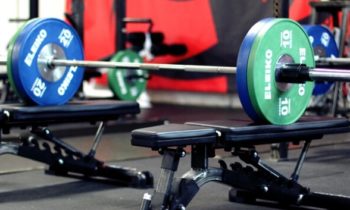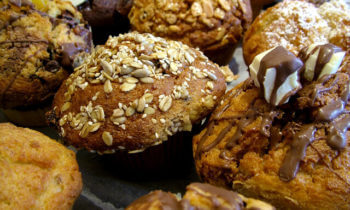It was hard focusing when all I could hear was some guy shouting UP, UP, UP!
After awhile, this shouting began to annoy me. I decided to put down my weights and find out what was going on.
Turning the corner, I saw what appeared to be an angry man standing over and shouting down - to a very tired guy - lying flat on his back - in the middle of the exercise room.
 I couldn’t believe how loud he was. The trainer was standing with each foot on the side of this guys head. He was looking straight down into this poor fellow eyes. And every time he shouted UP, the guy would throw his legs and body upward in the attempt to hit his trainer’s hands. Then he would come back down, and lay completely flat on the floor.
I couldn’t believe how loud he was. The trainer was standing with each foot on the side of this guys head. He was looking straight down into this poor fellow eyes. And every time he shouted UP, the guy would throw his legs and body upward in the attempt to hit his trainer’s hands. Then he would come back down, and lay completely flat on the floor.
As I stood there observing, I noticed the trainer would slowly lift his hands higher and higher. This caused the other guy to have to throw his body up so high that sometimes it only left his head remaining on the floor.
This went on until the man started barking orders to start another form of torturous exercise.
Now, I have no idea what the man was training for. However, the routine was extremely intense, potentially dangerous, and lasted long into my time on the elliptical machine.
If you’ve been to a gym long enough, you’ve probably seen others in similar situations. To be honest, I doubt these types of exercise routines are really good for you for the long haul. They may be good preparing for a competition, but it’s not typically why most of us go to a gym.
Losing weight is like a triangle.
We all know that for some, going to the gym is just too much work. However, losing weight does require work on our part. It’s also important to note that losing weight and keeping weight off are two different things.
The good news is we have three ways to both lose weight and keep it off at the same time. Here are the three common ways to lose weight (like the three sides of a triangle).
- Diet - Cutting down on daily calorie intake.
- Cardio/Aerobic exercise - Increasing heart rate through prolonged movement like running, swimming, biking, walking and various sports.
- Resistance Training - Putting pressure on muscles by lifting weights, or doing push-up/pull-up/sit-ups etc.
Before we go on, I believe the foundation of losing weight and keeping it off lies in cutting back our calorie intake (the bottom of a triangle). However, studies have proven the effectiveness of Aerobic exercise on burning body fat, and resistance training for building and maintaining muscle mass. And sometimes a quick resistance training workout is a great supplement to various cardiovascular/aerobic exercises.
To lift or not to lift
 Realistically, Lifting Weights and Resistance Training can be done pretty much anywhere. I personally go more often if I have a nice gym. There’s something about leaving the comfort of home, and going where other similar minded people work out. It’s also easier to find a spotter or workout partner.
Realistically, Lifting Weights and Resistance Training can be done pretty much anywhere. I personally go more often if I have a nice gym. There’s something about leaving the comfort of home, and going where other similar minded people work out. It’s also easier to find a spotter or workout partner.
I also find the pressure of monthly payments helps motivate me to keep working out. Yet regardless of where you do resistance training, it can be an important way to improve health, lose weight and keep it off.
Let’s start by looking at an article from the Harvard Gazette entitled: Using weights to target belly fat
“Healthy men who did 20 minutes of daily weight training had less increase in age-related abdominal fat than men who spent the same amount of time doing aerobic activities, according to a new study by Harvard T.H. Chan School of Public Health (HSPH) researchers and colleagues. Combining weight training and aerobic activity led to the most optimal results. Aerobic exercise by itself was associated with less weight gain compared with weight training.”
The study appears online today in Obesity. “Because aging is associated with sarcopenia, the loss of skeletal muscle mass, relying on body weight alone is insufficient for the study of healthy aging,” said lead author Rania Mekary, a researcher in HSPH’s Department of Nutrition. “Measuring waist circumference is a better indicator of healthy body composition among older adults. Engaging in resistance training or, ideally, combining it with aerobic exercise, could help older adults lessen abdominal fat while increasing or perserving muscle mass.”
Here is an article called Resistance Exercise in Individuals With and Without Cardiovascular Disease from the American Heart Association Science Advisory.
“Moderate-to-high-intensity resistance training performed 2 to 3 days per week for 3 to 6 months improves muscular strength and endurance in men and women of all ages by 25% to 100%, depending on the training stimulus and initial level of strength…
These findings suggest that improved endurance is not a function of aerobic exercise alone, but can be significantly enhanced by increased muscular strength…
Many cardiac patients lack the physical strength and/or self-confidence to perform common activities of daily living. Mild-to-moderate resistance training can provide an effective method for improving muscular strength and endurance, preventing and managing a variety of chronic medical conditions, modifying coronary risk factors, and enhancing psychosocial well-being.
Weight training has also been shown to attenuate the rate-pressure product when any given load is lifted.18 Thus, resistance training can decrease myocardial demands during daily activities such as carrying groceries or lifting moderate-to-heavy objects…
Because long-term compliance remains a challenge for adult fitness and exercise-based cardiac rehabilitation programs, resistance training can provide a means for maintaining interest and increasing diversity….”
Here is one of the most comprehensive studies I found on Lifting Weights and Resistance Training, taken from the Journal of Applied Physiology. The study was entitled: Effects of aerobic and/or resistance training on body mass and fat mass in overweight or obese adults
“For some time we have been interested in how much exercise and what types (modes) are most beneficial for acquiring health effects, cognizant of the fact that not any one amount or type of exercise is likely to be best for every health benefit (29). Previous research has shown Resistance Training (RT) to improve glucose tolerance and glycosylated hemoglobin, as well as strength and lean body mass (25)….
Considerable interest to both the general public and the scientific community are the control of weight gain and the extent of weight loss and change in body composition induced by exercise training. The STRRIDE-AT/RT research study provided a unique opportunity to investigate the relative benefits of resistance training when compared with aerobic training and the combination of the two on body composition measures, particularly total body mass and fat mass.
To our knowledge, the current report represents the largest randomized trial to directly compare changes in body composition induced by comparable amounts of time spent doing resistance and aerobic training, or both in combination, in nondiabetic, previously inactive overweight or obese adults…
Resistance training and changes in total body mass and absolute fat mass.
…RT induced significant gains in lean body mass and strength (Table 2). The lack of body mass loss observed with RT in this study supports the findings of others and is driven by an increase in lean body mass (6, 7, 9, 11, 21, 24, 26). However, there are conflicting reports in the literature on whether or not RT induces fat mass loss: some randomized controlled trials find that RT significantly reduces fat mass (24), while others either report a statistically insignificant trend (23, 26) or no change in fat mass (7, 9, 19). The present study supports the latter observation. However, it should be emphasized that RT significantly (P < 0.05) improved lean body mass as confirmed by both BOD POD and thigh muscle area measurements…
Recommendations from the American College of Sports Medicine (2009) provide a figure that proposes three potential mechanisms by which RT might lead to fat mass loss (11). Although the authors state that the literature examining the effect of RT on fat mass is inconclusive and that resistance training is not effective for weight loss, RT is still endorsed as an effective means for obesity treatment. Similarly, other consensus documents and study reports include tables showing that RT results in decreases in fat percentage, with the suggestion that this decrease in fat percent indicates a decrease in fat mass…
Aerobic vs. resistance training and body composition changes.
It is important for the clinician to understand whether aerobic or resistance training is superior in inducing changes in overall body composition. Comparisons between Aerobic Training (AT) and (Resistance Training (RT) groups in the current study suggest that AT decreases both body weight and fat mass significantly more than does RT. While the two modes of exercise produced statistically similar changes in body fat percentage, these changes were driven by different mechanisms, where RT increased lean body mass and AT decreased fat mass….
Conclusion.
The data support the following conclusions. Although it was more effective for lean body mass gains, RT did not significantly reduce either fat mass or total body mass. AT was more effective than RT for the reduction of fat and body mass in previously sedentary, nondiabetic, overweight or obese adults. While requiring double the time commitment, a program of combined AT and RT did not result in a greater loss of fat mass or body mass over AT. If increasing muscle mass and strength is the goal, a program including RT is required….”
Weight Loss: Lifting Weights and Resistance Training Conclusion:
Most of the research covered in this short article showed that Aerobic exercise is the quickest way to lose overall body fat. However, most indicated for overall health, a combination of the two showed the best returns (weight loss by the reduction of fat and body mass, and an increase in muscle mass standing and stamina. This is not to mention the increase in metabolism, heart health, diabetes control and reduction being overweight on the joints and skeletal frame.
So if you want to lose weight and keep it off, I suggest adding light resistance training to any weight loss regimen you’re considering.



